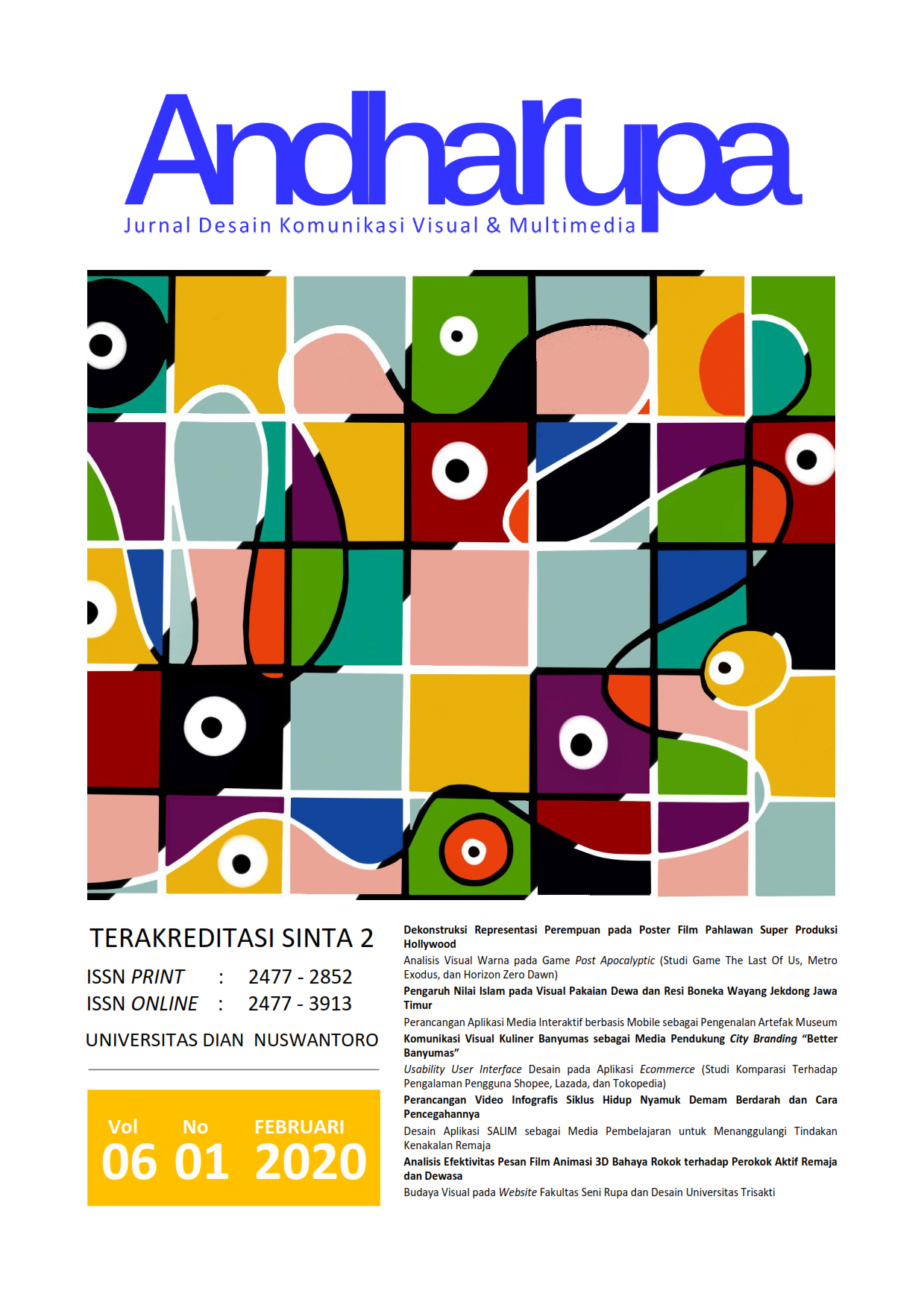Dekonstruksi Representasi Perempuan pada Poster Film Pahlawan Super Produksi Hollywood
DOI:
https://doi.org/10.33633/andharupa.v6i1.3234Abstract
AbstrakDekonstruksi representasi perempuan dalam film, sebagai bentuk ekspresi sosial budaya, merupakan sebuah upaya untuk membongkar tradisi yang didominasi nilai-nilai patriaki baik yang digambarkan secara terang-terangan maupun tersamar. Tujuan dari upaya tersebut untuk memperlihatkan bagaimana hegemoni dari nilai patriarki yang selalu menempatkan perempuan pada posisi marginal, dieksploitasi, dan diobjekkan oleh laki-laki. Beberapa perilaku perempuan dalam film direpresentasikan untuk dikonstruksikan secara normatif oleh masyarakat daripada perilaku lainnya. Representasi perempuan dalam film bergenre superhero baru mengalami perbaikan sejak akhir dekade lalu. Superhero perempuan mulai ditampilkan karakternya dan direpresentasikan sebagai individu yang mandiri berkepribadian kuat, mereka memiliki impian, cita-cita dan keinginan sendiri yang tidak berhubungan dengan menjadi objek afeksi karakter laki-laki. Cerita dan penokohan dalam film terefleksikan jelas pada visualisasi karakter dan materi promosi film berupa poster. Kata Kunci: dekonstruksi patriarki, gender, semiotik, film Hollywood, poster  AbstractThe deconstruction of the representation of women in film, as a form of socio-cultural expression, is an attempt to dismantle traditions that are dominated by patriarchal values either explicitly or disguised. The purpose of these efforts is to show the hegemony of patriarchal value that always puts women in a marginal position, exploited and objectified by men. Some women's behaviors in the film represented to construed normatively by society instead of other attitudes. Representation of woman characters in the superhero film genre started to improve since the last decade. Female superheroes begin showing character and represented as independent individuals strong personalities, have dreams, have goals, have desires of their own that are unrelated to become the object of affection of a male character. Stories and characterizations in films are cleary reflected in the visualization of the characters and promotional material in the form of posters. Keywords: gender, Hollywood movie, patriarchy deconstruction, poster, semioticReferences
Barker, Chris. (2011). Cultural Studies: Theory and Practice (fourth). SAGE Publications Ltd.
d’Estries, Michael. (2018). The evolution of Wonder Woman’s iconic costume. Fromthegrapevine. https://www.fromthegrapevine.com/arts/wonder-woman-costume-history-gal-gadot
Dutt, R. (2014). Behind the curtain: women’s representations in contemporary Hollywood. http://www.lse.ac.uk/media@lse/research/mediaWorkingPapers/MScDissertationSeries/2013/msc/112-Dutt.pdf
Dwijowijoto, R. N. (2008). Gender dan administrasi publik (1st ed.). Pustaka Pelajar.
Early, Francis H.. (2001). Staking Her Claim: Buffy the Vampire Slayer as Transgressive Woman Warrior. The Journal of Popular Culture, 35(3), 11–27. https://doi.org/10.1111/j.0022-3840.2001.3503_11.x
Fakih, Mansour. (2016). Analisis Gender dan Transformasi Sosial (15th ed.). INSISTPress. https://insistpress.com/katalog/analisis-gender-dan-transformasi-sosial/
Fischer, Sabrina. (2010). Powerful or Pretty: A Content Analysis of Gender Images in Children’s Animated Films [Auburn University]. https://etd.auburn.edu/bitstream/handle/10415/2065/ThesisSabrinaFischer.pdf;jsessionid=D2B74A2F2DD65BCEFC5FB17041B83F34?sequence=2
Gerard, M. P. (2018). Black Widow: Female Representation in the Marvel Cinematic Universe. Polymath: An Interdisciplinary Arts and Sciences Journal, 8(2), 27–53. https://ojcs.siue.edu/ojs/index.php/polymath/article/view/3314
Heldman, C., Frankel, L. L., & Holmes, J. (2016). “Hot, Black Leather, Whipâ€: The (De)evolution of Female Protagonists in Action Cinema. Sage Journals, 2(2). https://doi.org/10.1177/2374623815627789
Mau, Alfred Ena. (2016). Kesetaraan Gender : “Peran Antara Laki-laki dan Perempuan Yang Seimbang.†Bengkelappek.Org. http://www.bengkelappek.org/opini/174 -kesetaraan-gender-peran-antara-laki-laki-dan-perempuan-yang-seimbang.html
McKay, B. D. (2013). The use of digital photography in systematics. Biological Journal of the Linnean Society, 110(1), 1–13. https://doi.org/10.1111/bij.12086
Moore, Henrietta L. (1994). A Passion for Difference: Essays in Anthropology and Gender. Indiana University Press.
Parker, Holt N. (2011). Toward A Definition Of Popular Culture. History and Theory, 50(2), 147–170. https://doi.org/0.11111/j.1468-2303.2011.00574.x
Pasquine, F. (2013). Gender Inequality in Film. NYFA. https://www.nyfa.edu/film-school-blog/gender-inequality-in-film/
Pennell, H., & Behm-Morawitz, E. (2015). The empowering (super) heroine? The effects of sexualized female characters in superhero films on women. Sex Roles: A Journal of Research, 72(5), 211–220. https://doi.org/https://doi.org/10.1007/s11199-015-0455-3
Stabile, C. (2009). “Sweetheart, This Ain’t Gender Studiesâ€: Sexism and Superheroes. Communication and Critical/Cultural Studies, 6(1), 86–92. https://doi.org/10.1080/14791420802663686
Downloads
Published
Issue
Section
License
Copyright (c) 2020 ANDHARUPA: Jurnal Desain Komunikasi Visual & Multimedia

This work is licensed under a Creative Commons Attribution 4.0 International License.
Authors who publish with this journal agree to the following terms:
- Authors retain copyright and grant the journal right of first publication with the work simultaneously licensed under a Creative Commons Attribution License that allows others to share the work with an acknowledgment of the work's authorship and initial publication in this journal.
- Authors are able to enter into separate, additional contractual arrangements for the non-exclusive distribution of the journal's published version of the work (e.g., post it to an institutional repository or publish it in a book), with an acknowledgment of its initial publication in this journal.
- Authors are permitted and encouraged to post their work online (e.g., in institutional repositories or on their website) prior to and during the submission process, as it can lead to productive exchanges, as well as earlier and greater citation of published work (See The Effect of Open Access).















